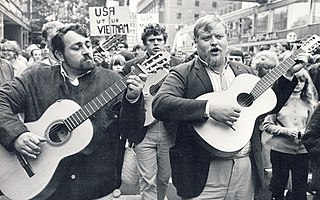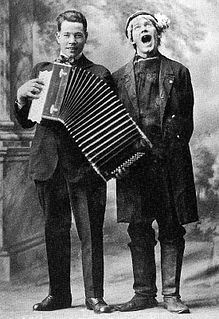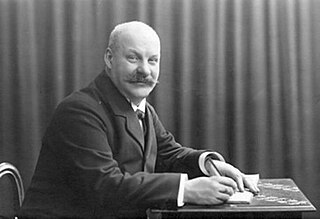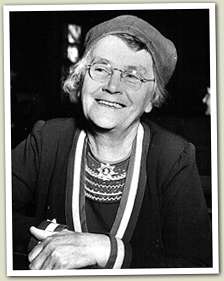
Göran BrorBennyAndersson is a Swedish singer, musician, composer, producer, member of the Swedish music group ABBA and co-composer of the musicals Chess, Kristina från Duvemåla, and Mamma Mia! For the 2008 film version of Mamma Mia! and its 2018 sequel, Mamma Mia! Here We Go Again, he worked also as an executive producer. Since 2001, he has been active with his own band Benny Anderssons orkester.

Ernst Ragnar Johansson, professionally known as Ernst Rolf was a Swedish actor, singer and composer and musical revue artist. Rolf was born in Falun in the Swedish province of Dalarna, where his father was a tailor and member of the temperance movement. His musical talent was evident from the start when even as a young child he performed at IOGT meetings. He would sing while his older brother Birger played the piano.

Fred Åkerström was a Swedish folk guitarist and singer particularly noted for his interpretations of Carl Michael Bellman's music, and his own work of the typically Swedish song segment named visa. These songs, visor, are traditionally very narrative and the performance is "acted" to some degree. The singer is in context a vissångare, a troubadour character. Åkerström was also known for his actor's interpretations of Bellman's 18th century material, and his unusual ability to reach deep bass notes.
Charles Godfrey Widdén (1874-1933) was a Swedish-born singer and comedian, who performed regularly in Worcester, Massachusetts and New York City during the years 1900 - 1920 and achieved national prominence through his numerous recordings.

Hjalmar Peterson was a singer and comedian from Sweden, who achieved great popularity during the 1910s and 1920s. His stage name was Olle i Skratthult.
Michael Östen Andersson is a Swedish former football player and manager, he previously worked as CEO of Hammarby IF

Emil Norlander (1865-1935) was a Swedish journalist, author, songwriter and producer of musical revues.

Lars Bondeson (1865-1908) was the stage name of Carl Jansson-Öhlin, who was one of the founders of Swedish bondkomik. Born in Örebro in 1865, he was a singer, storyteller, lyricist and music publisher. His songbooks were a major influence on countless entertainers in Sweden and America.

Joel Mossberg was a Swedish-American singer, educator and choir director, who was active between the years 1900 and 1940.

Known as the father of bondkomik, Jödde i Göljaryd (1855–1900) was a beloved storyteller, whose folk humor and songs dominated popular culture in Sweden during the 1890s.
Lyricist Göran Svenning and composer David Hellström were a top Swedish songwriting team of the early 20th century. Together they wrote over thirty waltzes, including the classic Kostervalsen.

Carsten Thorvald Woll (1885-1962) was a leading Norwegian-American singer and recording artist of the 1910s and 1920s.
Theodor Larsson (1880–1937) was a Swedish songwriter and comedian.
Ted Johnson was a Swedish-American violinist, who led a popular Scandinavian dance band in the Twin Cities during the 1930s and 1940s.

Lydia Hedberg (1878–1964) was a Swedish singer, who performed in folk costume and was known as Bergslagsmor.

Ragnar Hasselgren was a Swedish-born singer and recording artist, who was active on the American West Coast from the 1920s through the 1970s.

Gustav Fonandern (1880-1960) was a Swedish architect, singer and recording artist, who spent considerable time in the United States during the 1920s.

Anna-Lisa Öst (1889-1974) was a Swedish gospel singer and recording artist, who was popular with both Swedish and Swedish-American audiences in the 1940s and 1950s. She performed in folk costume and was better known as Lapp-Lisa, a name reflecting the Sami heritage of her home district.
Calle Lindström (1868-1955) was a Swedish singer and comedian from Östergötland.

Smith & Thell are a pop/folk band based in Stockholm, Sweden. The duo, composed of Maria Smith and Victor Thell, first met one another as young teenagers at a local music event in their hometown of Helsingborg in Southern Sweden.


















